The Museum of Christian Art has a rich collection of art objects produced from the 16th to the 20th century, originally intended for churches, convents and private oratories. The collection includes paintings, books, textiles, wood and ivory sculptures, liturgical objects, jewelry and furniture.
Before the arrival of the Portuguese in Goa, in 1510, there was already a well established Goan school of art, represented by families or groups with close interaction with prevailing artistic trends who received royal patronage to produce images, sculptures and paintings of local deities.
During the early period of the Portuguese rule, images and other objects of Christian liturgy as well as furniture and artefacts of daily life were brought from Portugal and other places in Europe. But as they were not sent in large quantities, local artists were commissioned to create new items to meet the increasing demand. Over time, unique artworks were produced not only to meet local needs, but also intended to be shipped abroad. The silversmiths, goldsmiths and woodcarvers imprinted their own Indian style on these productions, giving rise to a synthesis of two different cultures, embodied in a substantial part of what has been later recognized as Indo- Portuguese art.
Some of the highlights from the MoCA Collection:
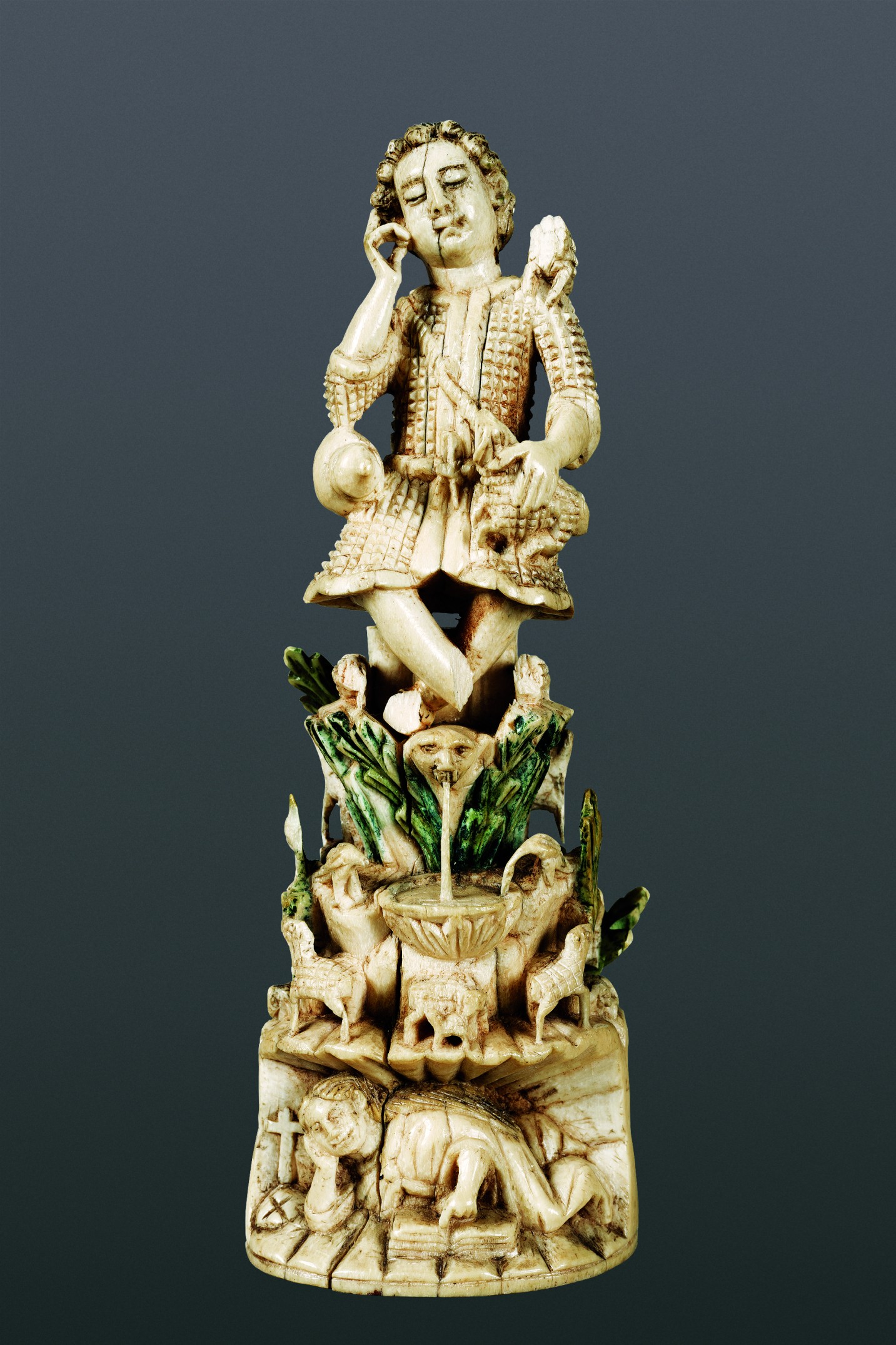
An intricate 17th-century ivory representation of Jesus as the Good Shepherd depicts a young boy in sheepskin with gambolling sheep at his feet, and one leaping over his left shoulder. The pedestal is made to resemble a terraced hillock. Jutting out from the upper level is a face representing the fount of life, from whose mouth the water of life gushes into a basin, from which birds of paradise drink. On the lower level is a figure of a holy penitent performing penance in a cave. Lush green foliage symbolic of the Tree of Life would have been part of the original, but is now lost.

Special reference should be made to the monumental tabernacle monstrance in the form of a pelican, originally made for the church of the Convent of Santa Monica. This artwork causes an immediate impact due to its large proportions and the silver coating the wooden structure. It is composed of a spherical base – a symbol of the universe – where there is a cavity, easily accessed through an opening at the back that corresponds to the tabernacle. The pelican, which symbolises parental love, in Christian iconography has been transposed to the sacrifice of Christ on the Calvary and resurrection. It stands on the globe with open wings in a scenic posture. It is depicted piercing its own breast, where an aperture encircled by a radiated halo served to present the consecrated hosts to the congregation during the eucharistic ceremony; at its feet, two starving offspring are waiting to be nourished by their mother’s blood.
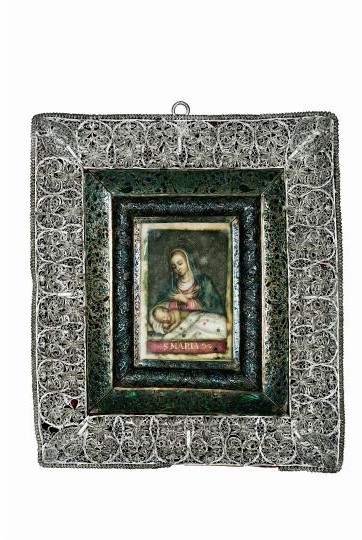
The delicate painting of Virgin and Child shows Mary with her arms folded at her breast gazing down at the sleeping Jesus. The painting is notable also for its multiple frames — one bearing stylised leaf motifs, another with floral and animal motifs, yet another with scrolling Mughal-style paisleys and the final outermost frame worked in fine silver filigree.
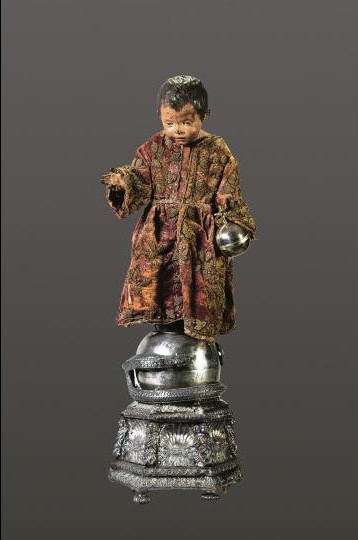
This image of Infant Jesus Saviour of the World shows two independent styles– one purely European (the Infant) and the other Indo-Portuguese (the base) – that merge harmoniously. The European characteristics include the Infant’s anatomical form and technical details such as the use of silver-plated tin and the flesh tints on the body.
The image’s base comprises a globe on a silver-clad wood base. The Indian elements are evident in the goldsmith’s treatment of the serpent with overlapping scales wrapped around the sphere, and the water-leafed plant forms, shell designs and pointed lozenges. Nagas stand out on the already Indianized piece. The gold-embroidered velvet gown was made in India where the art of gold thread embroidery (zardozi) was practiced to a high degree of perfection.
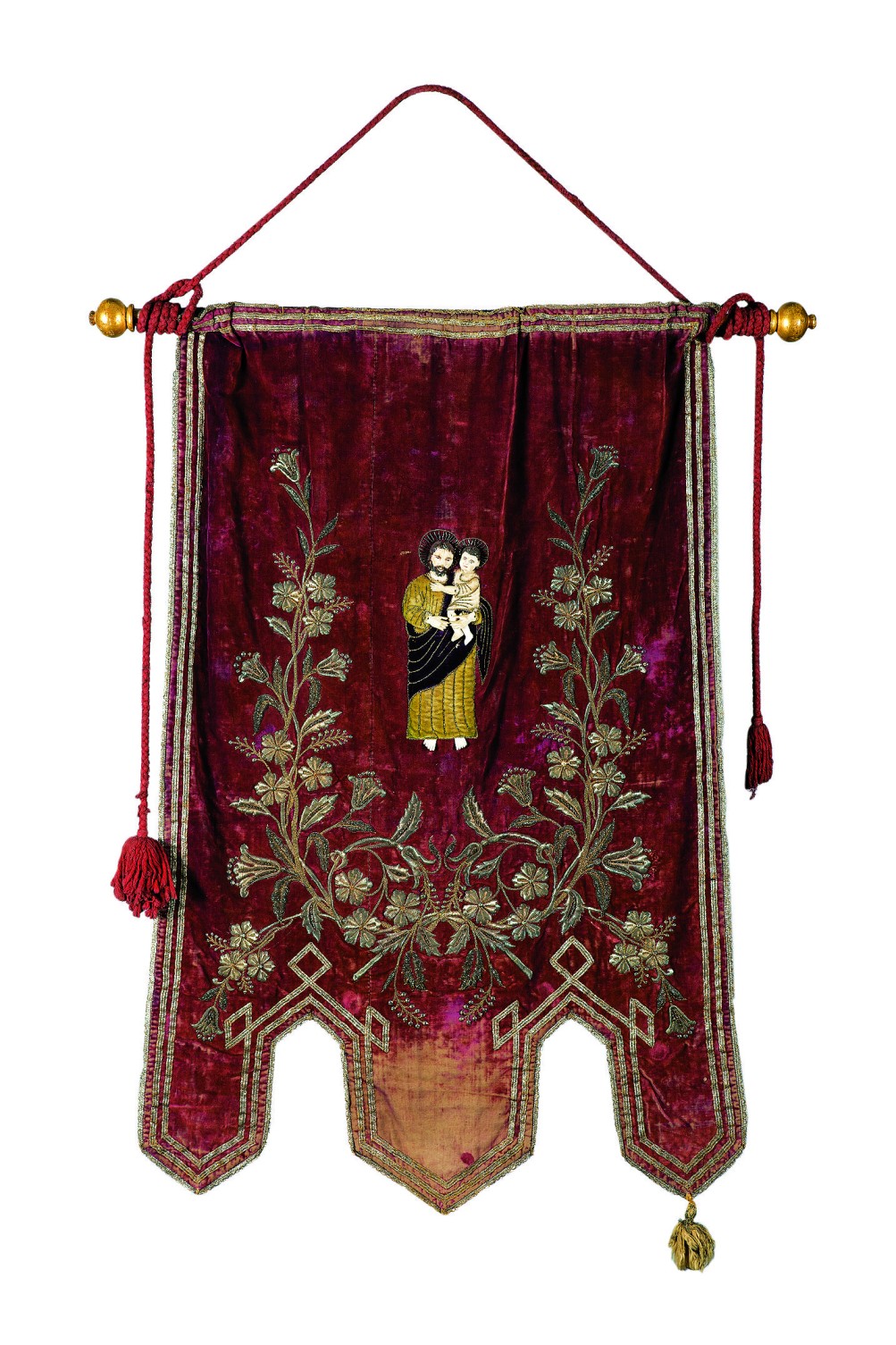
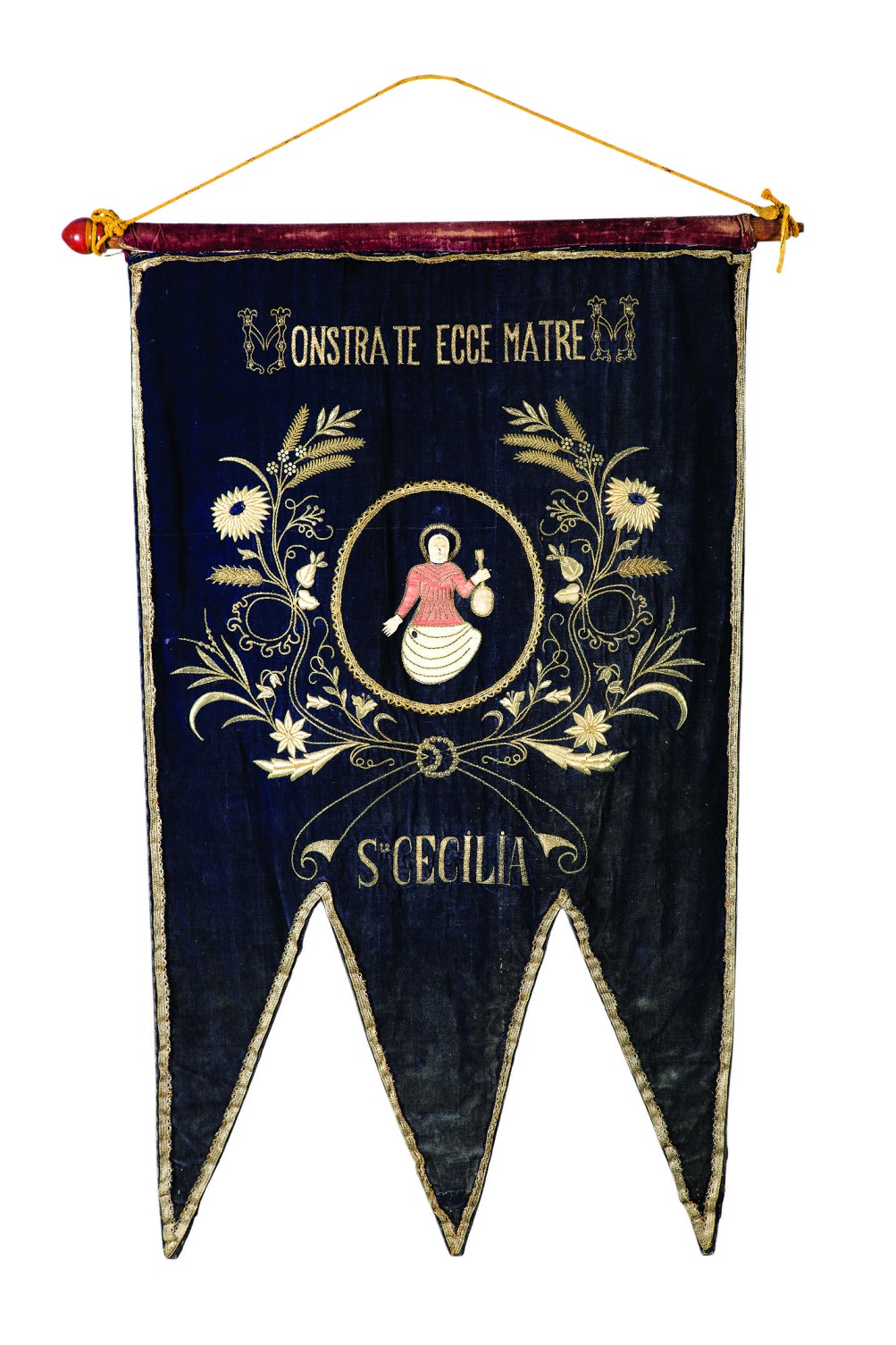
Processional banners, generally large, are cut from rich fabric in a rectangular design, with the bottom part either ending in points or indented, usually depicted a painted or embroidered image of the Virgin or one of the saints. This processional banner hangs from a horizontal staff with knobs at the ends. Galloons and two thick cords ending in large tassels are used for both, decoration and as guides to help the member who carried this banner.
This banner belonged to the Confraternity of Saint Joseph as can be seen from the image of the saint depicted on one side of the banner. The image of the Virgin Mary is depicted on the other side of the banner. The images are seen in the simple embroidered relief images where the hands and faces of the images on the banners are of ivory – a unique feature of banners made in Goa.
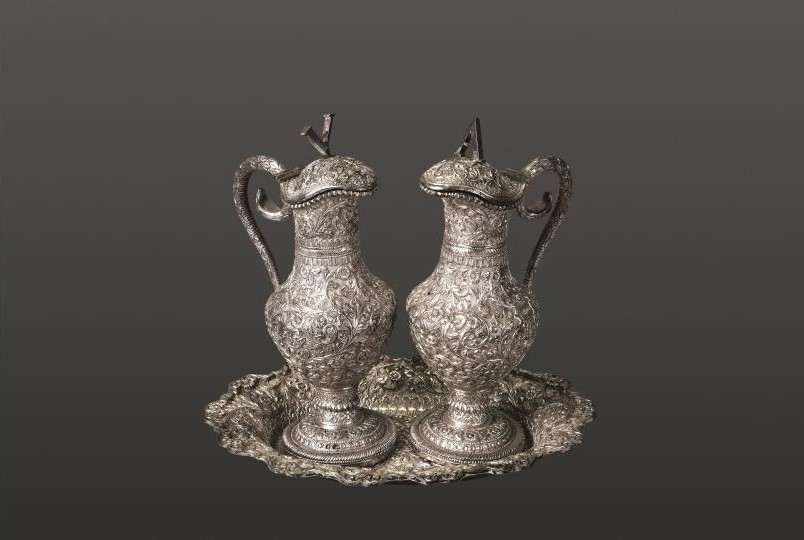
This pair of cruets with circular bases is executed entirely in silver and crowned with the letters A and V. It is profusely decorated in engraved plant motifs that completely cover the surface of the cruets and the oblong tray that supports them. Such completeness of decoration is indicative of typical Indian style. Of interest are the handles which simulate snakes, clearly an Indian inspiration.

This mid-20th century ivory depiction of the Virgin Mary is very interesting in the way that it associates Christian and Hindu themes. The Virgin is shown standing on the crescent moon, but also rising from a lotus. She is draped in a saree. Significant too is the fact that both Hindu crown and a Christian halo are represented, each demonstrating her divine nature. One also can see the dove of the Holy Spirit right at the top.
About:
The Museum of Christian Art (MoCA) is located on the picturesque Holy Hill in Old Goa within the 17th century Convent of Santa Monica. The first of its kind in Asia, MoCA was set up in collaboration with the Calouste Gulbenkian Foundation, Portugal and the Indian National Trust for Art and Cultural Heritage (INTACH), New Delhi.
Recognised globally as a perfect symbiosis of two cultural manifestations, Indian and European, the art objects at MoCA are known for their antiquity and distinct Indo-Portuguese influence and have attracted visitors and research scholars not only from India but also from all over the world. It is marked as a ‘Must See’ in most international travel guides and art objects from the collection have been sought for international exhibitions.
The recently upgraded museum is open to visitors daily, from 10:00 hours to 17:00 hours. The collection can also be viewed online at www.museumofchristianart.com







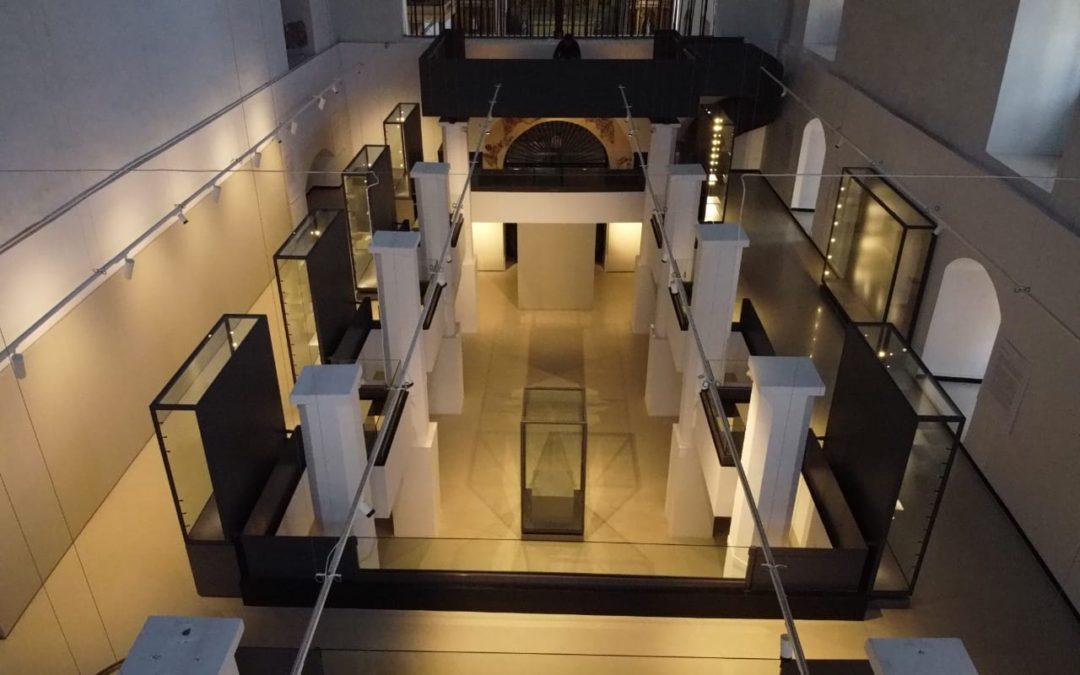
Recent Comments